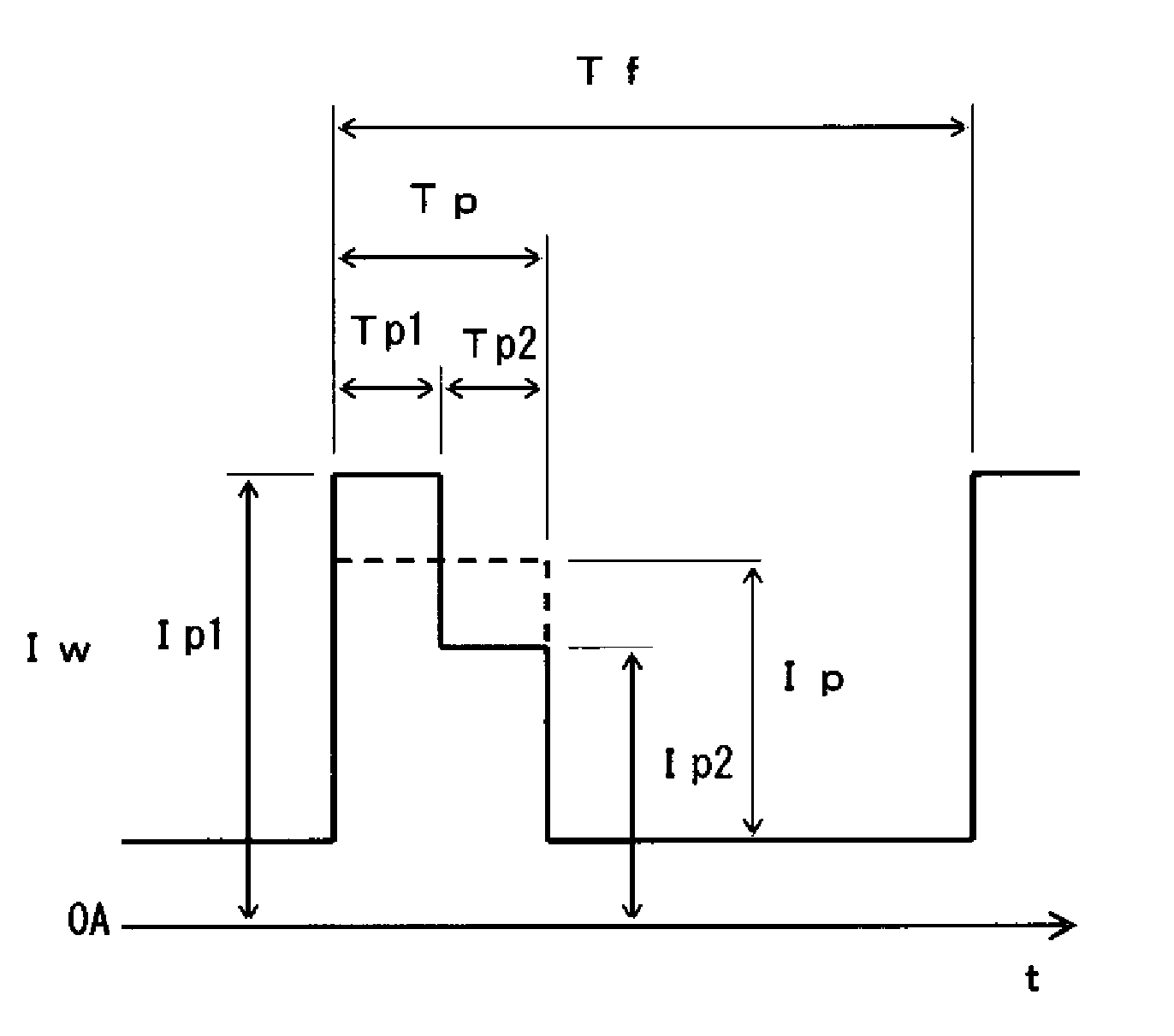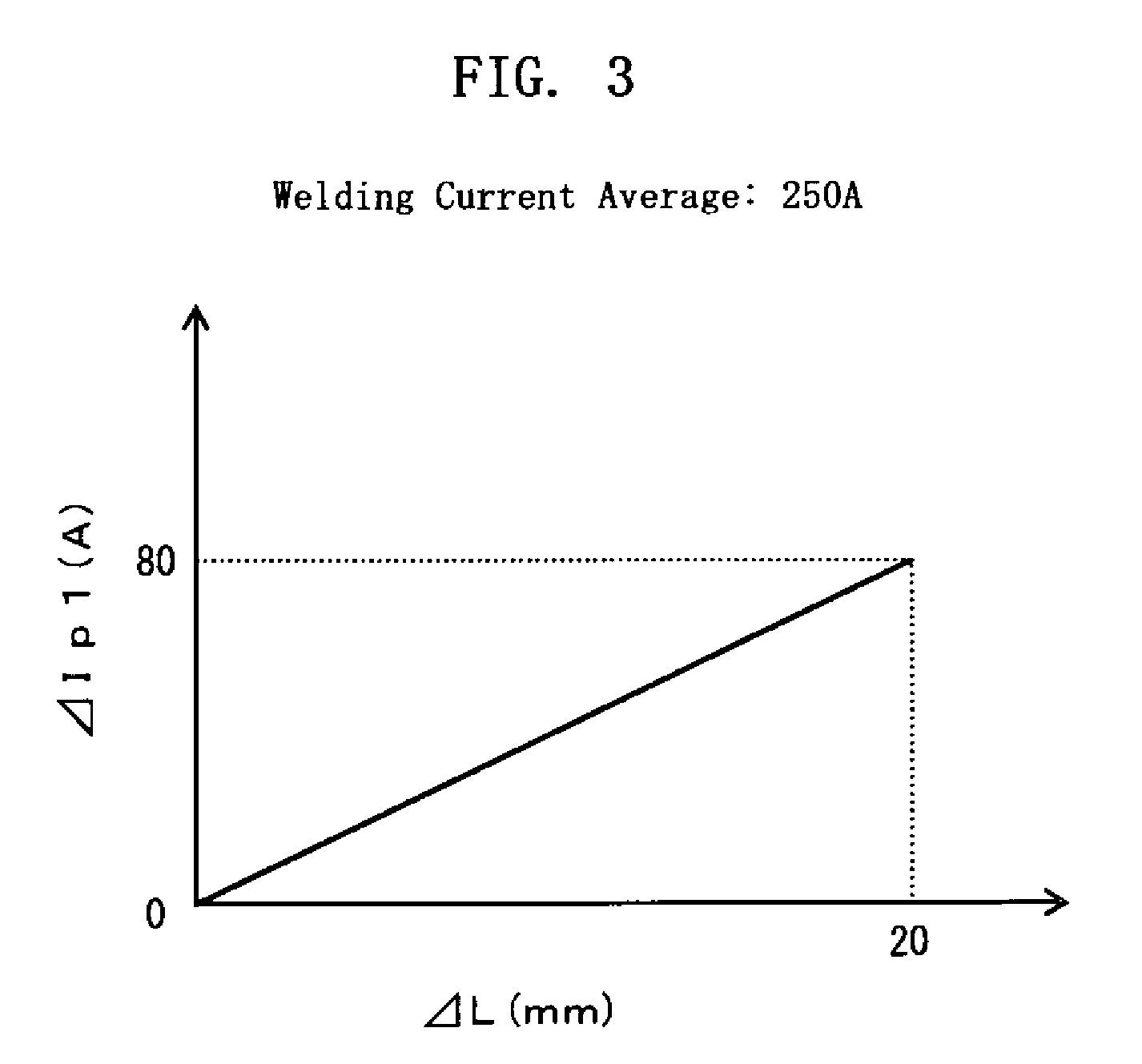Pulse arc welding method
a technology of arc welding and arc welding, which is applied in the direction of arc welding apparatus, welding apparatus, manufacturing tools, etc., can solve the problems of unstable arc, reset the unit, and inability to work normally, and achieve the effect of stable arc condition
- Summary
- Abstract
- Description
- Claims
- Application Information
AI Technical Summary
Benefits of technology
Problems solved by technology
Method used
Image
Examples
first embodiment
[0037]FIG. 1 shows the waveform of a welding current Iw in a pulse arc welding method according to the present invention. As shown in the figure, a peak time Tp is made up of two consecutive periods of times, i.e. a first peak time Tp1 and a second peak time Tp2 that follows the first peak time Tp1 without any interruptions. During the first peak time Tp1, a first peak current Ip1 is applied to flow through a welding wire and a base metal, while during the second peak time Tp2, a second peak current Ip2 is applied, which is smaller in value than the first peak current Ip1. Thus, the peak time current as a whole has a step-like form, with the right-hand part reduced below the left-hand part.
[0038]As indicated in broken lines in FIG. 1, the conventional peak time current is fixed to have a constant value Ip. The first peak current Ip1 is greater than the constant value Ip. The application of the first peak current Ip1 in the first peak time Tp1 contributes to positioning an arc anode ...
second embodiment
[0058]the present invention will now be described below.
[0059]According to the second embodiment, the welding current Iw (FIG. 1) described above in the first embodiment is also applied, and in addition, a control is performed for stabilizing the welding condition even when the tip-base distance becomes greater than the reference value.
[0060]Specifically, when the tip-base distance becomes greater than the reference value, the arc length control is conducted so as to maintain the arc length, and for this purpose the wire extension is made greater. Heat input for droplet formation comes from the arc heat and Joule heat at the extending portion of the wire. Accordingly, a greater wire extension leads to increased Joule heat and increased heat input for droplet formation, and excessive heat input may hinder a proper droplet transfer. This problem becomes more significant as the tip-base distance becomes greater. In order to overcome this problem, according to the second embodiment, the...
third embodiment
[0070]the present invention will now be described below.
[0071]According to the third embodiment, the distance difference signal ΔL described above for the first and the second embodiments is calculated from the welding current average setting signal Iar and the welding current average.
[0072]FIG. 8 is a block diagram of a welding power source for implementing the pulse arc welding method according to the third embodiment. In FIG. 8, those blocks which are identical or similar to those described above with reference to FIG. 4 and FIG. 7 are indicated by the same reference symbols. FIG. 8 is essentially the same as FIG. 7, differing in that the interface circuit IF is replaced by a second interface circuit IF2 drawn in broken lines, the distance difference calculation circuit DL is replaced by a second the distance difference calculation circuit DL2, and a welding current average detection circuit IAV is added.
[0073]The second interface circuit IF2 receives the welding condition signal...
PUM
| Property | Measurement | Unit |
|---|---|---|
| distance Lw | aaaaa | aaaaa |
| diameter | aaaaa | aaaaa |
| current | aaaaa | aaaaa |
Abstract
Description
Claims
Application Information
 Login to View More
Login to View More - R&D
- Intellectual Property
- Life Sciences
- Materials
- Tech Scout
- Unparalleled Data Quality
- Higher Quality Content
- 60% Fewer Hallucinations
Browse by: Latest US Patents, China's latest patents, Technical Efficacy Thesaurus, Application Domain, Technology Topic, Popular Technical Reports.
© 2025 PatSnap. All rights reserved.Legal|Privacy policy|Modern Slavery Act Transparency Statement|Sitemap|About US| Contact US: help@patsnap.com



